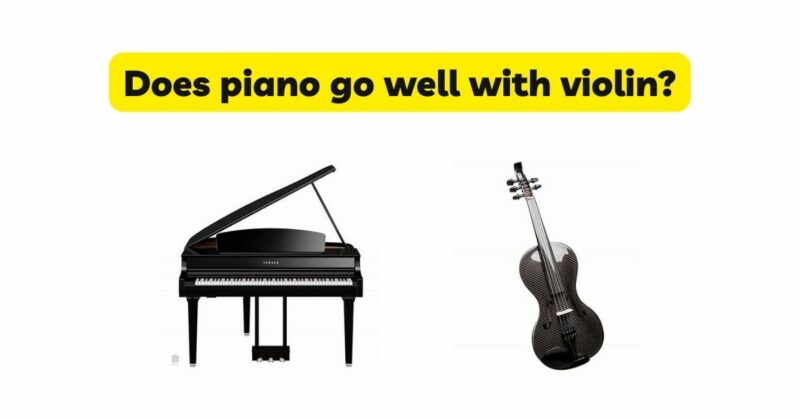In the realm of music, certain instrument combinations create enchanting and captivating sounds when played together. One such pairing is the piano and the violin, a timeless duo that has enthralled audiences for centuries. In this article, we will explore the beautiful synergy and complementary nature of the piano and the violin. By examining their unique tonal qualities, expressive capabilities, collaborative opportunities, and historical significance, we aim to highlight why the piano and the violin go so well together, creating an irresistible musical partnership.
Tonal Qualities and Expressive Range:
The piano and the violin possess distinct tonal qualities that, when combined, create a rich and expressive palette of sounds. The piano’s versatility, with its wide range and ability to produce multiple notes simultaneously, provides a solid harmonic foundation. Its resonant and percussive nature brings warmth and depth to the ensemble. On the other hand, the violin’s melodic and expressive qualities make it akin to the human voice. Its ability to sustain long, singing tones and produce intricate, emotional melodies adds a captivating and emotive element to the pairing. The contrasting yet complementary tonal qualities of the piano and the violin create a balanced and harmonious blend that captivates listeners and evokes a wide range of emotions.
Collaborative Opportunities and Chamber Music:
The piano and the violin have a long-standing tradition of collaboration, particularly in the realm of chamber music. The repertoire for piano and violin spans across various musical periods and genres, from classical sonatas to romantic concertos to contemporary compositions. Their compatibility allows for intricate musical dialogues, exchanges of melodies and harmonies, and the exploration of musical nuances. Through chamber music, pianists and violinists have the opportunity to engage in close musical interaction, responding to each other’s phrasing, dynamics, and expressiveness. The collaborative nature of piano and violin playing creates an intimate and captivating experience that showcases the deep musical connection between the two instruments.
Historical Significance and Iconic Compositions:
The combination of piano and violin has a rich historical significance, with countless iconic compositions that have become staples of the classical repertoire. The violin-piano duo has inspired renowned composers throughout history, resulting in masterpieces that continue to captivate audiences. From Mozart’s Sonata for Piano and Violin to Beethoven’s “Kreutzer” Sonata to Brahms’ Violin Sonatas, these compositions showcase the exquisite interplay between the two instruments and the inherent beauty of their combination. The piano’s ability to accompany and provide harmonic support to the violin, combined with the violin’s expressive melodies, has led to the creation of some of the most beloved and enduring works in classical music.
Expressive Possibilities and Dynamic Range:
The combination of piano and violin offers an extensive range of expressive possibilities and dynamic contrasts. Together, they can create a wide spectrum of musical textures, from delicate and intimate passages to powerful and dramatic climaxes. The piano’s ability to play both softly and forcefully, coupled with the violin’s ability to evoke a range of emotions through its lyrical and expressive qualities, allows for a nuanced and emotionally charged performance. The interplay between the instruments enables musicians to shape the music, convey complex emotions, and engage listeners on a deeply emotional level.
Versatility and Adaptability:
One of the remarkable aspects of the piano and violin combination is its versatility and adaptability to various musical genres and settings. While often associated with classical music, the piano and violin duo transcends boundaries and can be found in jazz, folk, and even contemporary genres. The inherent flexibility of both instruments allows musicians to explore different styles, experiment with improvisation, and adapt their performance to suit various musical contexts. This versatility makes the piano and violin pairing not only captivating in traditional chamber music settings but also adaptable to modern and eclectic musical collaborations.
Educational Benefits and Musicianship:
Playing in a piano and violin duo offers significant educational benefits for musicians. Both pianists and violinists develop essential skills such as ensemble playing, active listening, and musical sensitivity. Collaborative music-making nurtures musicianship, fostering the ability to respond and adapt to other musicians in real-time. Through the piano and violin partnership, musicians learn the art of blending their individual voices, supporting each other, and creating a unified musical expression. This experience enhances their overall musicianship, facilitating growth as performers and deepening their understanding of the intricacies of musical communication.
Audience Appeal and Musical Experience:
The combination of piano and violin has a wide appeal to audiences of all ages and musical backgrounds. The melodic and expressive qualities of the violin, combined with the harmonic richness and versatility of the piano, create a captivating and accessible musical experience. The intimate nature of the piano and violin duo allows listeners to connect with the musicians on a personal and emotional level. Whether in a concert hall or an intimate setting, the enchanting sounds of the piano and violin together have the power to transport and deeply move the audience.
Conclusion:
The piano and the violin form an enduring duo that exudes elegance, expressiveness, and a captivating musical connection. Their tonal qualities, expressive range, collaborative opportunities, and historical significance make them a match made in musical heaven. Together, they create a harmonious blend that enchants audiences and evokes a wide range of emotions. The piano and violin combination is not only cherished in classical music but also adaptable to various genres and settings, showcasing their versatility and adaptability. Whether in iconic compositions or contemporary explorations, the piano and violin duo continues to captivate both musicians and listeners, highlighting the profound beauty and timeless appeal of their musical partnership.


